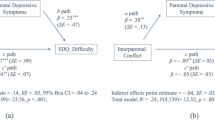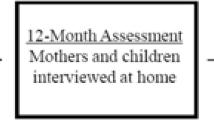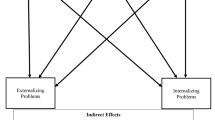Abstract
Parental divorce has been extensively documented as a risk factor for adolescent psychosocial functions. However, recent empirical findings argue that adolescents following parental divorce are not disadvantaged, indicating that adolescents’ reactions to parental divorce may vary substantially. Given these mixed findings in the existing literature, the current study uses a person-centered approach to explore psychosocial adjustment profiles in Chinese adolescents and compare these emerging profiles between adolescents from divorced and intact families. Likewise, this study investigates the direct and interactive effects of paternal attachment, maternal attachment, adolescent’s gender, and family structure (divorced vs. intact) on these emerging profiles. A total of 681 adolescents aged 13 to 18 years old (M age = 15.64; SD = 1.59) were involved in this study. Of these adolescents, 237 adolescents (59% girls) were from divorced families, and 444 adolescents (66% girls) were from intact families. The results of a latent profile analysis showed four empirically driven adjustment profiles: severely maladaptive, slightly maladaptive, indifferent, and adaptive. Adolescents from divorced families exhibited a higher proportion of the severely maladaptive profile and a lower percentage of the adaptive profile than those from intact families. Moreover, the results of a multinomial logistic regression exhibited that parental divorce enhanced the probability of being members of the maladaptive profile (vs. the adaptive profile) for boys. In addition, girls from divorced families with secure maternal attachment were more likely to be members of the adaptive profile (vs. the slightly maladaptive). The current findings indicate that Chinese adolescents following parental divorce exhibit a maladaptive pattern of psychosocial functions, and this maladjustment pattern is particularly heightened for boys. Secure maternal attachment significantly contributes to girls’ (but not boys’) post-divorce adaptive functions.



Similar content being viewed by others
Data Availability
The datasets generated during and/or analysed during the current study are available from the corresponding author on reasonable request.
References
Achenbach, T. M. (1991). Manual for the youth self-report and 1991 profiles. Burlington: University of Vermont.
Ahrons, C. R., & Tanner, J. L. (2003). Adult children and their fathers: Relationship changes 20 years after parental divorce. Family Relations, 52, 340–351. https://doi.org/10.1111/j.1741-3729.2003.00340.x.
Aiken, L. S., & West, S. G. (1991). Multiple regression: Testing and interpreting interactions. Thousand Oaks: Sage Publications.
Amato, P. R. (2000). The consequences of divorce for adults and children. Journal of Marriage and Family, 62, 1269–1287. https://doi.org/10.1111/j.1741-3737.2000.01269.x.
Armsden, G. C., & Greenberg, M. T. (1987). The inventory of parent and peer attachment: Individual differences and their relationship to psychological well-being in adolescence. Journal of Youth and Adolescence, 16, 427–454.
Asher, S. R., Hymel, S., & Renshaw, P. D. (1984). Loneliness in children. Child Development, 55, 1456–1464. https://doi.org/10.2307/1130015.
Baude, A., Pearson, J., & Drapeau, S. (2016). Child adjustment in joint physical custody versus sole custody: A meta-analytic review. Journal of Divorce and Remarriage, 57, 338–360. https://doi.org/10.1080/10502556.2016.1185203.
Booth, A., & Amato, P. R. (1994). Parental marital quality, parental divorce, and relations with parents. Journal of Marriage and the Family, 56, 21–34.
Bowlby, J. (1969). Attachment and loss: Vol. 1. Attachment. London: Hogarth Press.
Bowlby, J. (1982). Attachment and loss—retrospect and prospect. American Journal of Orthopsychiatry, 52, 664–678.
Bowlby, J., & Ainsworth, M. (2013). The origins of attachment theory. Attachment Theory: Social, Developmental, and Clinical Perspectives, 45, 759–775.
Bradburn, N. M. (1969). The structure of psychological well-being. Chicago: Aldine.
Bradley, R. H., & Corwyn, R. F. (2002). Socioeconomic status and child development. Annual Review of Psychology, 53, 371–399. https://doi.org/10.1146/annurev.psych.53.100901.135233.
Charzyńska, E. (2020). It does matter who we are grateful to: A latent profile analysis. Current Psychology, 39, 1–12. https://doi.org/10.1007/s12144-019-00361-3.
Chou, K. L. (2000). Intimacy and psychosocial adjustment in Hong Kong Chinese adolescents. The Journal of Genetic Psychology, 161, 141–151. https://doi.org/10.1080/00221320009596701.
Cooke, J. E., Kochendorfer, L. B., Stuart-Parrigon, K. L., Koehn, A. J., & Kerns, K. A. (2018). Parent-child attachment and children’s experience and regulation of emotion: A meta-analytic review. Emotion, 19, 1103–1126. https://doi.org/10.1037/emo0000504.
Costa, S., Sireno, S., Larcan, R., & Cuzzocrea, F. (2019). The six dimensions of parenting and adolescent psychological adjustment: The mediating role of psychological needs. Scandinavian Journal of Psychology, 60, 128–137. https://doi.org/10.1111/sjop.12507.
Crockett, L. J., Moilanen, K. L., Raffaelli, M., & Randall, B. A. (2006). Psychological profiles and adolescent adjustment: A person-centered approach. Development and Psychopathology, 18, 195–214. https://doi.org/10.1017/S0954579406060111.
Cui, G., & Lan, X. (2020). The associations of parental harsh discipline, adolescents’ gender, and grit profiles with aggressive behavior among Chinese early adolescents. Frontiers in Psychology, 11, 323. https://doi.org/10.3389/fpsyg.2020.00323.
Cui, N., Xue, J., Connolly, C. A., & Liu, J. (2016). Does the gender of parent or child matter in child maltreatment in China? Child Abuse & Neglect, 54, 1–9. https://doi.org/10.1016/j.chiabu.2016.01.003.
Diener, E. (2000). Subjective well-being: The science of happiness and a proposal for a national index. American Psychologist, 55, 34–43. https://doi.org/10.1037/0003-066X.55.1.34.
Dong, Q., Wang, Y., & Ollendick, T. H. (2002). Consequences of divorce on the adjustment of children in China. Journal of Clinical Child and Adolescent Psychology, 31, 101–110.
Eisenberg, N., Fabes, R. A., & Spinrad, T. L. (2006). Prosocial development. In N. Eisenberg, W. Damon, & R. M. Lerner (Eds.), Handbook of child psychology Vol. 3: Social, emotional and personality development (pp. 646–718). Hoboken: Wiley.
Elam, K. K., Sandler, I., Wolchik, S., & Tein, J. Y. (2016). Non-residential father-child involvement, interparental conflict and mental health of children following divorce: A person-focused approach. Journal of Youth and Adolescence, 45, 581–593. https://doi.org/10.1007/s10964-015-0399-5.
Elam, K. K., Sandler, I., Wolchik, S. A., Tein, J. Y., & Rogers, A. (2019). Latent profiles of postdivorce parenting time, conflict, and quality: Children’s adjustment associations. Journal of Family Psychology, 33, 499–510. https://doi.org/10.1037/fam0000484.
Emery, R. E. (2011). Renegotiating family relationships: Divorce, child custody, and mediation. New York: Guilford Press.
Faber, A. J., & Wittenborn, A. K. (2010). The role of attachment in children’s adjustment to divorce and remarriage. Journal of Family Psychotherapy, 21, 89–104. https://doi.org/10.1080/08975353.2010.483625.
Fan, C. S., & Lui, H. K. (2004). Extramarital affairs, marital satisfaction, and divorce: Evidence from Hong Kong. Contemporary Economic Policy, 22, 442–452. https://doi.org/10.1093/cep/byh033.
Greenspoon, P. J., & Saklofske, D. H. (2001). Toward an integration of subjective well-being and psychopathology. Social Indicators Research, 54, 81–108. https://doi.org/10.1023/A:1007219227883.
Guo, X. (2019a). Coping as a mediator between parental attachment and resilience: An examination of differential effects between Chinese adolescents from single parent families versus those from intact families. Psychological Reports, 122, 506–524. https://doi.org/10.1177/0033294118765418.
Guo, X. (2019b). The association between family structure and subjective well-being among emerging adults in China: Examining the sequential mediation effects of maternal attachment, peer attachment, and self-efficacy. Journal of Adult Development, 26, 22–30.
Hadfield, K., Amos, M., Ungar, M., Gosselin, J., & Ganong, L. (2018). Do changes to family structure affect child and family outcomes? A systematic review of the instability hypothesis. Journal of Family Theory and Review, 10, 87–110. https://doi.org/10.1111/jftr.12243.
Ho, D. Y. F. (1987). Fatherhood in Chinese culture. In M. E. Lamb (Ed.), The father's role: Cross-cultural perspectives (pp. 227–245). Hillsdale: Erlbaum.
Hu, Y. (2020). Marital disruption, remarriage and child well-being in China. Journal of Family Issues, 0192513X20917779. https://doi.org/10.1177/0192513X20917779.
Huebner, E. S. (1994). Preliminary development and validation of a multidimensional life satisfaction scale for children. Psychological Assessment, 6, 149–158.
IBM Corp. (2012). IBM SPSS statistics for windows, version 21.0. Armonk: IBM Corp.
Kelly, J. B., & Emery, R. E. (2003). Children’s adjustment following divorce: Risk and resilience perspectives. Family Relations, 52, 352–362. https://doi.org/10.1111/j.1741-3729.2003.00352.x.
Kim, S. Y., Chen, S., Sim, L., & Hou, Y. (2017). Stability and change in parenting and adjustment profiles across early, middle, and late adolescence in Chinese American families. In Asian American parenting (pp. 69–88). Cham: Springer.
Lan, X. (2020). Grit and peer relationships in early adolescence: A person-centered approach. Journal of Social and Personal Relationships, 37, 2250–2269. https://doi.org/10.1177/0265407520921557.
Lan, X., & Zhang, L. (2019). Shields for emotional well-being in Chinese adolescents who switch schools: The role of teacher autonomy support and grit. Frontiers in Psychology, 10, 2384. https://doi.org/10.3389/fpsyg.2019.02384.
Lan, X., Marci, T., & Moscardino, U. (2019). Parental autonomy support, grit, and psychological adjustment in Chinese adolescents from divorced families. Journal of Family Psychology, 33, 511–520. https://doi.org/10.1037/fam0000514.
Lan, X., Scrimin, S., & Moscardino, U. (2019). Perceived parental guan and school adjustment among Chinese early adolescents: the moderatingrole of interdependent self-construal. Journal of Adolescence, 71, 18–27. https://doi.org/10.1016/j.adolescence.2018.12.003
Lansford, J. E. (2009). Parental divorce and children’s adjustment. Perspectives on Psychological Science, 4, 140–152. https://doi.org/10.1111/j.1745-6924.2009.01114.x.
Lasgaard, M., Goossens, L., Bramsen, R. H., Trillingsgaard, T., & Elklit, A. (2011). Different sources of loneliness are associated with different forms of psychopathology in adolescence. Journal of Research in Personality, 45, 233–237. https://doi.org/10.1016/j.jrp.2010.12.005.
Lee, E. J., & Bukowski, W. M. (2012). Co-development of internalizing and externalizing problem behaviors: Causal direction and common vulnerability. Journal of Adolescence, 35, 713–729. https://doi.org/10.1016/j.adolescence.2011.10.008.
Lemeshow, S., Sturdivant, R. X., & Hosmer, D. W. (2013). Applied logistic regression (Wiley series in probability and statistics). Hoboken: Wiley.
Leon, K. (2003). Risk and protective factors in young children's adjustment to parental divorce: A review of the research. Family Relations, 52, 258–270. https://doi.org/10.1111/j.1741-3729.2003.00258.x.
Li, X., & Lamb, M. E. (2013). Fathers in Chinese culture. In D. W. Shwalb, B. J. Shwalb, & M. E. Lamb (Eds.), Fathers in cultural context (pp. 15–41). New York: Routledge.
Li, J. B., Delvecchio, E., Miconi, D., Salcuni, S., & Di Riso, D. (2014). Parental attachment among Chinese, Italian, and Costa Rican adolescents: A cross-cultural study. Personality and Individual Differences, 71, 118–123. https://doi.org/10.1016/j.paid.2014.07.036.
Little, R. J., & Rubin, D. B. (1987). Statistical analysis with missing data. New York: Wiley.
Liu, J., Chen, X., Zhou, Y., Li, D., Fu, R., & Coplan, R. J. (2017). Relations of shyness-sensitivity and unsociability with adjustment in middle childhood and early adolescence in suburban Chinese children. International Journal of Behavioral Development, 41, 681–687. https://doi.org/10.1177/0165025416664195.
Lizardi, D., Thompson, R. G., Keyes, K., & Hasin, D. (2009). Parental divorce, parental depression, and gender differences in adult offspring suicide attempt. The Journal of Nervous and Mental Disease, 197, 899–904. https://doi.org/10.1097/NMD.0b013e3181c299ac.
Luk, J. W., Farhat, T., Iannotti, R. J., & Simons-Morton, B. G. (2010). Parent-child communication and substance use among adolescents: Do father and mother communication play a different role for sons and daughters? Addictive Behaviors, 35, 426–431. https://doi.org/10.1016/j.addbeh.2009.12.009.
Ma, L., Rizzi, E., & Turunen, J. (2018a). Children and divorce in China. Stockholm Research Reports in Demography.
Ma, L., Turunen, J., & Rizzi, E. (2018b). Divorce Chinese style. Journal of Marriage and Family, 80, 1287–1297. https://doi.org/10.1111/jomf.12484.
Ma, C., Ma, Y., Wang, Y., & Lan, X. (2019). Empathy and psychosocial adjustment in Tibetan and Han adolescents: A person-centered approach. Frontiers in Psychology, 10, 1896. https://doi.org/10.3389/fpsyg.2019.01896.
Madigan, S., Brumariu, L. E., Villani, V., Atkinson, L., & Lyons-Ruth, K. (2016). Representational and questionnaire measures of attachment: A meta-analysis of relations to child internalizing and externalizing problems. Psychological Bulletin, 142, 367–399. https://doi.org/10.1037/bul0000029.
Marsh, H. W., Lüdtke, O., Trautwein, U., & Morin, A. J. (2009). Classical latent profile analysis of academic self-concept dimensions: Synergy of person-and variable-centered approaches to theoretical models of self-concept. Structural Equation Modeling: A Multidisciplinary Journal, 16, 191–225. https://doi.org/10.1080/10705510902751010.
Muthén, L. K., & Muthén, B. O. (2012). Mplus User's guide: Statistical analysis with latent variables (7th ed.). Los Angeles: Muthén & Muthén.
Nie, Y. G., Li, J. B., & Vazsonyi, A. T. (2016). Self-control mediates the associations between parental attachment and prosocial behavior among Chinese adolescents. Personality and Individual Differences, 96, 36–39. https://doi.org/10.1016/j.paid.2016.02.077.
Nylund, K. L., Asparouhov, T., & Muthén, B. O. (2007). Deciding on the number of classes in latent class analysis and growth mixture modeling: A Monte Carlo simulation study. Structural Equation Modeling: A Multidisciplinary Journal, 14, 535–569. https://doi.org/10.1080/10705510701575396.
Pan, Y., Zhang, D., Liu, Y., Ran, G., & Teng, Z. (2016). Different effects of paternal and maternal attachment on psychological health among Chinese secondary school students. Journal of Child and Family Studies, 25, 2998–3008. https://doi.org/10.1007/s10826-016-0463-0.
Piqueras, J. A., Mateu-Martínez, O., Cejudo, J., & Pérez-González, J. C. (2019). Pathways into psychosocial adjustment in children: Modeling the effects of trait emotional intelligence, social-emotional problems, and gender. Frontiers in Psychology, 10, 507. https://doi.org/10.3389/fpsyg.2019.00507.
Podsakoff, P. M., MacKenzie, S. B., Lee, J. Y., & Podsakoff, N. P. (2003). Common method biases in behavioral research: A critical review of the literature and recommended remedies. Journal of Applied Psychology, 88, 879–903. https://doi.org/10.1037/0021-9010.88.5.879.
Rosenberg, M. (1965). Society and the adolescent self-image. Princeton: Princeton University Press.
Rossi, A. S. (1984). Gender and parenthood. American Sociological Review, 49, 1–19.
Sands, A., Thompson, E. J., & Gaysina, D. (2017). Long-term influences of parental divorce on offspring affective disorders: A systematic review and meta-analysis. Journal of Affective Disorders, 218, 105–114. https://doi.org/10.1016/j.jad.2017.04.015.
Schuessler, K., Hittle, D., & Cardascia, J. (1978). Measuring responding desirably with attitude-opinion items. Social Psychology, 41(3), 224–235.
Song, H., Thompson, R. A., & Ferrer, E. (2009). Attachment and self-evaluation in Chinese adolescents: Age and gender differences. Journal of Adolescence, 32, 1267–1286. https://doi.org/10.1016/j.adolescence.2009.01.001.
Storch, E. A., Larson, M. J., Ehrenreich-May, J., Arnold, E. B., Jones, A. M., Renno, P., Fujii, C., Lewin, A. B., Mutch, P. J., Murphy, T. K., & Wood, J. J. (2012). Peer victimization in youth with autism spectrum disorders and co-occurring anxiety: Relations with psychopathology and loneliness. Journal of Developmental and Physical Disabilities, 24, 575–590. https://doi.org/10.1007/s10882-012-9290-4.
Størksen, I., Røysamb, E., Moum, T., & Tambs, K. (2005). Adolescents with a childhood experience of parental divorce: A longitudinal study of mental health and adjustment. Journal of Adolescence, 28, 725–739. https://doi.org/10.1016/j.adolescence.2005.01.001.
Størksen, I., Røysamb, E., Holmen, T. L., & Tambs, K. (2006). Adolescent adjustment and well-being: Effects of parental divorce and distress. Scandinavian Journal of Psychology, 47(1), 75–84. https://doi.org/10.1111/j.1467-9450.2006.00494.x
Sullivan, P. L. (2005). Culture, divorce, and family mediation in Hong Kong. Family Court Review, 43, 109–123. https://doi.org/10.1111/j.1744-1617.2005.00011.x.
Tein, J. Y., Coxe, S., & Cham, H. (2013). Statistical power to detect the correct number of classes in latent profile analysis. Structural Equation Modeling: A Multidisciplinary Journal, 20, 640–657. https://doi.org/10.1080/10705511.2013.824781.
Thompson Jr., R. G., Alonzo, D., Hu, M. C., & Hasin, D. S. (2017). The influences of parental divorce and maternal-versus-paternal alcohol abuse on offspring lifetime suicide attempt. Drug and Alcohol Review, 36, 408–414. https://doi.org/10.1111/dar.12441.
Van der Wal, R. C., Finkenauer, C., & Visser, M. M. (2019). Reconciling mixed findings on children’s adjustment following high-conflict divorce. Journal of Child and Family Studies, 28, 468–478. https://doi.org/10.1007/s10826-018-1277-z.
Videon, T. M. (2002). The effects of parent-adolescent relationships and parental separation on adolescent well-being. Journal of Marriage and Family, 64, 489–503. https://doi.org/10.1111/j.1741-3737.2002.00489.x.
Wang, C. C. D., & Mallinckrodt, B. (2006). Acculturation, attachment, and psychosocial adjustment of Chinese/Taiwanese international students. Journal of Counseling Psychology, 53, 422–433.
Wang, C. K. J., Sun, Y., Liu, W. C., & Yao, J. (2015). Latent profile analysis of the physical self-description among Chinese adolescents. Current Psychology, 34, 282–293. https://doi.org/10.1007/s12144-014-9257-y.
Wolchik, S. A., Schenck, C. E., & Sandler, I. N. (2009). Promoting resilience in youth from divorced families: Lessons learned from experimental trials of the new beginnings program. Journal of Personality, 77, 1833–1868. https://doi.org/10.1111/j.1467-6494.2009.00602.x.
Xu, A., Zhang, J., & Xia, Y. R. (2008). Impacts of parents' divorce on Chinese children: A model with academic performance as a mediator. Marriage & Family Review, 42, 91–119. https://doi.org/10.1300/J002v42n03_05.
Yeh, K. H., & Bedford, O. (2004). Filial belief and parent-child conflict. International Journal of Psychology, 39, 132–144. https://doi.org/10.1080/00207590344000312.
Zhang, C. (2020). Are children from divorced single-parent families disadvantaged? New evidence from the China family panel studies. Chinese Sociological Review, 52, 84–114.
Zhang, Q., & Kou, Y. (2011). The dimension of measurement on prosocial behavior: Exploration and confirmation. Sociological Studies, 4, 105–121.
Zhao, J., Li, Q., Wang, L., Lin, L., & Zhang, W. (2019). Latent profile analysis of left-behind adolescents' psychosocial adaptation in rural China. Journal of Youth and Adolescence, 48, 1146–1160. https://doi.org/10.1007/s10964-019-00989-1.
Zhou, J., Jiang, S., Zhu, X., Huebner, E. S., & Tian, L. (2020). Profiles and transitions of dual-factor mental health among Chinese early adolescents: The predictive roles of perceived psychological need satisfaction and stress in school. Journal of Youth and Adolescence. https://doi.org/10.1007/s10964-020-01253-7.
China Statistics Yearbook. (2019). Table 22-25: Marriage services statistics. Retrieved: http://www.stats.gov.cn/tjsj/ndsj/2019/indexch.htm
Acknowledgments
We are grateful to all the participants and their families involved in the present research. Moreover, we would like to express our sincere gratitude to the editor and three anonymous reviewers whose constructive comments substantially improve this article’s quality.
Author information
Authors and Affiliations
Corresponding authors
Ethics declarations
Conflict of Interest
The authors declare that they have no conflict of interest.
Ethical Approval
All procedures followed were in accordance with the ethical standards of the responsible committee on human experimentation.
Informed Consent
Informed consent was obtained from all participants included in the study.
Additional information
Publisher’s Note
Springer Nature remains neutral with regard to jurisdictional claims in published maps and institutional affiliations.
Electronic supplementary material
ESM 1
(DOCX 22 kb)
Rights and permissions
About this article
Cite this article
Lan, X., Sun, Q. Exploring psychosocial adjustment profiles in Chinese adolescents from divorced families: The interplay of parental attachment and adolescent’s gender. Curr Psychol 41, 5832–5848 (2022). https://doi.org/10.1007/s12144-020-01097-1
Accepted:
Published:
Issue Date:
DOI: https://doi.org/10.1007/s12144-020-01097-1




